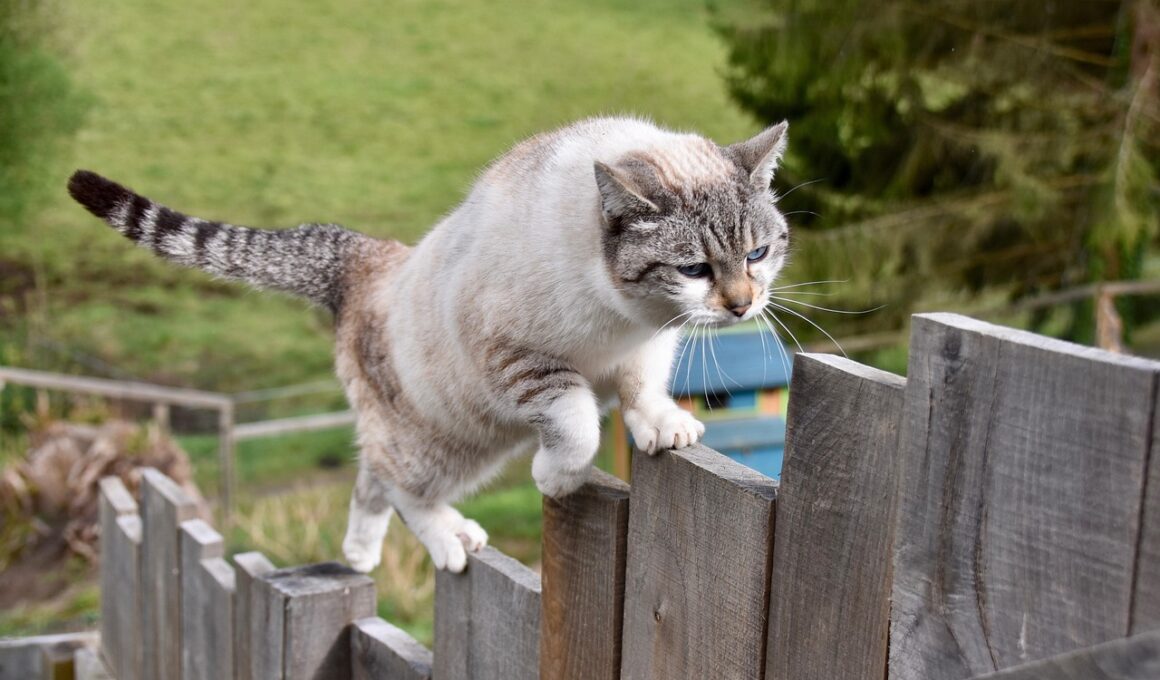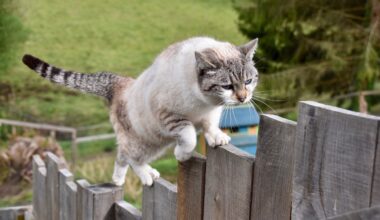Understanding Cat Agility Training
Agility training for cats is an increasingly popular way to engage their physical and mental energy. Before starting this exciting journey with your feline friend, it’s crucial to understand some vital safety precautions. First, ensure that your area is free of hazards and obstacles. This can include furniture, electrical cords, or any items that may be hazardous to a jumping cat. Next, prepare safe equipment that is specifically designed for cats, rather than improvising with household items which may pose risks. Furthermore, you should introduce agility elements gradually. Cats need time to adapt to new structures, so start slow with smaller jumps and low tunnels. Using treats or toys to motivate your cat can enhance their learning experience, and it promotes a positive training atmosphere. Additionally, always supervise your cat during training to prevent accidents. If they show signs of stress or fatigue, it’s essential to take a break rather than pushing them too hard. Training sessions should be fun and engaging for your cat, ensuring a successful agility training experience. Don’t forget that every cat is unique; allow them to evolve at their own pace for optimal results.
Preparing for Training Sessions
Prior to each agility training session, it’s essential to prepare both the environment and your cat for safety. Ensure the training space is well-lit and free from distractions to help your cat focus. Consider using non-slip materials for surfaces where your cat will perform, as this will minimize slippage and provide better grip. Examine all agility equipment for any sharp edges or points that might injure your cat. Regularly check tunnels and jumps to ensure they are sturdy and secure, avoiding equipment that wobbles or collapses. It’s also vital to have a first-aid kit nearby, containing items like antiseptic wipes and bandages for emergencies. Dress comfortably and avoid wearing items that might catch your cat’s attention, such as dangling jewelry or loose sleeves. Warm up sessions can be helpful to prevent strain or injury; simple stretches can make a significant difference. Each session must incorporate praise and rewards to motivate your cat positively. Remember that patience is key; you’re building trust as much as skill. A safe atmosphere and preparation lay the groundwork for a successful training experience that is enjoyable for both cat and owner.
The health of your cat is paramount, especially during agility training. Before committing to any training program, ensure your cat has received a thorough vet check-up. Discuss their health status with a veterinarian to determine if they are physically capable of engaging in agility exercises. Owning a cat that has existing health issues like arthritis or obesity can adversely affect their ability to train safely. Pay close attention to your cat’s behavior and body language during training. If your cat shows signs of distress, fatigue, or injury, it may be time to reassess your techniques or take a break. Hydration is equally important; always make fresh water available for your cat before, during, and after training sessions. Non-slip mats around training surfaces can help prevent accidental falls, which can injure your cat while leaping about. Prevent overheating by scheduling sessions in cooler parts of the day and taking breaks in shade or indoors. Understanding their limits and respecting their physical needs ensures that agility training remains a positive experience, fostering good health alongside new skills in a safe environment. Always be prepared to adjust your training pace based on your cat’s individual abilities.
Using Positive Reinforcement
Using positive reinforcement techniques can significantly affect how effectively you train your cat for agility courses. Rewarding desirable behaviors with treats or verbal praise helps reinforce those actions, making them more likely to be repeated. It’s essential to use treats that your cat enjoys, as this will motivate them during workouts. Timing is key; rewards should follow immediately after your cat performs the desired action correctly. This association helps create a clear connection between their performance and the reward. Always keep the training fun and engaging, which aids in building a strong bond between you and your cat. It’s also important to vary the types of rewards, as this can keep your cat interested and eager to learn more. Introduce new tricks progressively while maintaining the foundation they have already gained. Be careful not to overwhelm your cat with too many commands; focus on quality and clarity instead. If they seem to lose interest, return to simpler tasks they perform well to keep their spirits high. Consistency in training, combined with positive reinforcement, cultivates a joyful learning environment while minimizing stress and potential injuries for your feline companion.
Monitoring your cat during agility training is crucial for their safe growth and emotional well-being. Keep an eye on their stamina and enthusiasm throughout each session. If they seem unhappy or fatigued, consider shortening the duration of training or taking breaks more frequently. It’s important to pay close attention to how your cat reacts to various elements of the agility course. If they seem fearful or apprehensive of certain obstacles, reassess the training method and perhaps return to simpler exercises to build confidence. Gradually introducing new gadgets allows your cat to acclimatize to them better. Giving your cat breaks during training can help keep stress levels down; this will also prevent any physical strain that may occur. Providing a cozy area for your cat to rest during those breaks is advisable. Finally, always ensure that they are properly warmed up before engaging in rigorous exercise to facilitate healthy muscles and prevent injuries. Observing their behavior is essential; consider keeping a journal to track their progress and reactions to various techniques over time, ensuring that training remains a safe and enjoyable activity for your cat.
Establishing boundaries while training your cat for agility is essential to maintain safety and well-being throughout the process. Training sessions that begin to drag can lead to frustration, so make sure each session is kept concise and focused on one or two skills. Allocating certain days for specific activities can also help minimize overtraining, allowing your cat to have rest days between more challenging exercises. Reinforce that the training area is exclusively for agility training, limiting potential distractions from other pets or household activities. Be cautious of how your cat interacts with agility equipment; if they seem too excited, take a moment to refocus them with calmness and structured commands. It’s best to provide space to calm them down when they seem overstimulated. Additionally, ensure they are in a distraction-free zone, thus enhancing concentration and minimizing accidents. Reinforcing safety boundaries creates an inviting atmosphere for learning, allowing both you and your cat to enjoy training. Above all, be adaptable in your approach while consistently prioritizing safety, ensuring that the agility training becomes a fun, engaging experience for your furry friend.
Conclusion on Safe Agility Training
In conclusion, safety precautions are fundamental when conducting agility training with your cat. Safety must remain your top priority as you embark on this rewarding journey. Understanding your cat’s unique temperament and physical capabilities will help guide your training techniques effectively. You should be aware of your cat’s health and take appropriate steps to create a secure training environment, alleviating accidents and promoting a positive learning experience. Implementing positive reinforcement will keep your training fun and engaging, forging a strong bond between you and your pet. Regular monitoring during training can prevent fatigue or stress in your cat, allowing for progression at their own pace while respecting their limits. Incorporate breaks generously, ensuring your cat stays refreshed and motivated. Establish boundaries that define your training area, helping minimize distractions that might impede focus. Most importantly, enjoy this journey together; agility training should always strengthen your connection and mutual enjoyment. Take pride in your cat’s achievements while prioritizing their safety. With the right approach and considerations, not only will your cat learn new skills, but you will also create cherished memories through agility training sessions together.


